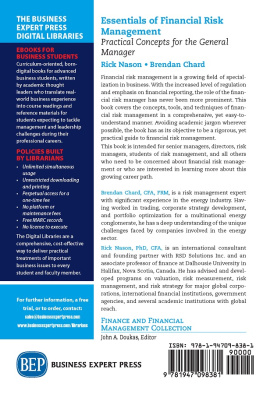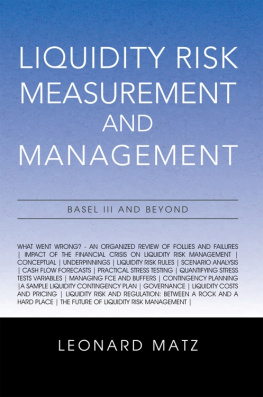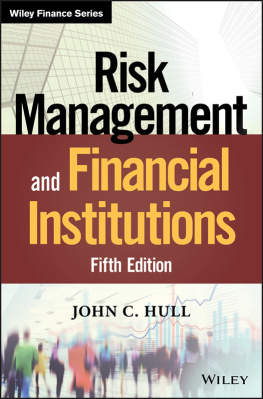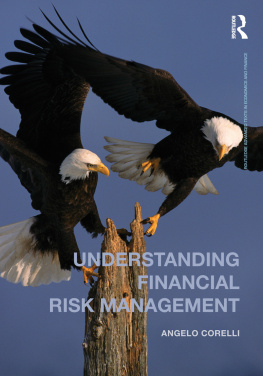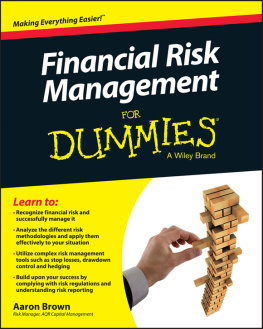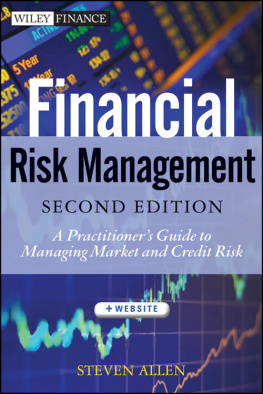VALUE AT RISK
VALUE AT RISK
The New Benchmark for Managing Financial Risk
THIRD EDITION
PHILIPPE JORION


Copyright 2007, by The McGraw-Hill Companies, Inc. All rights reserved. Except as permitted under the United States Copyright Act of 1976, no part of this publication may be reproduced or distributed in any form or by any means, or stored in a database or retrieval system, without the prior written permission of the publisher.
ISBN: 978-0-07-173692-3
MHID: 0-07-173692-1
The material in this eBook also appears in the print version of this title: ISBN: 978-0-07-146495-6, MHID: 0-07-146495-6.
All trademarks are trademarks of their respective owners. Rather than put a trademark symbol after every occurrence of a trademarked name, we use names in an editorial fashion only, and to the benefit of the trademark owner, with no intention of infringement of the trademark. Where such designations appear in this book, they have been printed with initial caps.
McGraw-Hill eBooks are available at special quantity discounts to use as premiums and sales promotions, or for use in corporate training programs. To contact a representative please e-mail us at bulksales@mcgraw-hill.com.
This publication is designed to provide accurate and authoritative information in regard to the subject matter covered. It is sold with the understanding that the publisher is not engaged in rendering legal, accounting, or other professional service. If legal advice or other expert assistance is required, the services of a competent professional person should be sought.
From a declaration of principles jointly adopted by a committee of the
American Bar Association and a committee of publishers.
TERMS OF USE
This is a copyrighted work and The McGraw-Hill Companies, Inc. (McGraw-Hill) and its licensors reserve all rights in and to the work. Use of this work is subject to these terms. Except as permitted under the Copyright Act of 1976 and the right to store and retrieve one copy of the work, you may not decompile, disassemble, reverse engineer, reproduce, modify, create derivative works based upon, transmit, distribute, disseminate, sell, publish or sublicense the work or any part of it without McGraw-Hills prior consent. You may use the work for your own noncommercial and personal use; any other use of the work is strictly prohibited. Your right to use the work may be terminated if you fail to comply with these terms.
THE WORK IS PROVIDED AS IS. McGRAW-HILL AND ITS LICENSORS MAKE NO GUARANTEES OR WARRANTIES AS TO THE ACCURACY, ADEQUACY OR COMPLETENESS OF OR RESULTS TO BE OBTAINED FROM USING THE WORK, INCLUDING ANY INFORMATION THAT CAN BE ACCESSED THROUGH THE WORK VIA HYPERLINK OR OTHERWISE, AND EXPRESSLY DISCLAIM ANY WARRANTY, EXPRESS OR IMPLIED, INCLUDING BUT NOT LIMITED TO IMPLIED WARRANTIES OF MERCHANTABILITY OR FITNESS FOR A PARTICULAR PURPOSE. McGraw-Hill and its licensors do not warrant or guarantee that the functions contained in the work will meet your requirements or that its operation will be uninterrupted or error free. Neither McGraw-Hill nor its licensors shall be liable to you or anyone else for any inaccuracy, error or omission, regardless of cause, in the work or for any damages resulting there from. McGraw-Hill has no responsibility for the content of any information accessed through the work. Under no circumstances shall McGraw-Hill and/or its licensors be liable for any indirect, incidental, special, punitive, consequential or similar damages that result from the use of or inability to use the work, even if any of them has been advised of the possibility of such damages. This limitation of liability shall apply to any claim or cause whatsoever whether such claim or cause arises in contract, tort or otherwise.
CONTENTS
PREFACE
THE RISK MANAGEMENT REVOLUTION
Risk management truly has experienced a revolution in the last few years. This was started by value at risk (VAR), a new method to measure financial-market risk that was developed in response to the financial disasters of the early 1990s. By now, the VAR methodology has spread well beyond derivatives and is totally changing the way institutions approach their financial risk.
The first edition of this book provided the first comprehensive description of value at risk. Published in 1996, it quickly established itself as an indispensable reference on VAR and has been called the industry standard. It has been translated into Chinese, Hungarian, Japanese, Korean, Polish, Portuguese, and Spanish.
A completely revised second edition followed in 2000. This edition had been vastly expanded in content, with the page count increasing from 332 to 544. This expansion reflected the new body of knowledge and wider applications of VAR methods.
Initially confined to measuring market risk, VAR is now being used to control and manage risk actively, well beyond derivatives. The VAR methodology is now helping us to quantify credit risk and operational risk, leading to the Holy Grail of firmwide risk management. The broader scope of this book was reflected in its new subtitle, which was changed from The New Benchmark for Controlling Market Risk to The New Benchmark for Managing Financial Risk.
Since 2000, the industry has experienced new developments that create a need for a new edition. This third edition has been thoroughly brought up-to-date, with new or revamped chapters on multivariate methods (including factor models, principal components, and copulas), VAR methods using extreme-value theory, risk budgeting, and portfolio optimization using VAR. The chapters on credit risk, operational risk, and integrated risk management have been substantially revised as well. All chapters now include the latest relevant developments in the field. To keep the size of this book manageable, less relevant topics have been dropped, including the chapter on the technology of risk that was fast becoming obsolete.
In addition, this book incorporates the most recent regulatory requirements, including Basel II, which helped the industry to clarify the measurement of credit and operational risks. To help readers, the book now uses Basel-compliant terminology. This edition also covers the latest financial disasters, including AIB and NAB. While such events still happen once in a while, their frequency seems to decrease over time, no doubt aided by the advent of risk management.
This new edition also draws risk management lessons from the Enron bankruptcy, the Argentina default, and the September 11 attacks. It incorporates the latest recommendations of the Counterparty Risk Management Policy Group.
Finally, because this book is used increasingly as a text in risk management courses, each chapter now has a list of questions that can be used as assignments to students or as mind-expanding exercises for inquisitive readers. All in all, this is a substantially expanded and improved edition.
WHAT IS VAR?
Value at risk traces it roots to the infamous financial disasters of the early 1990s that engulfed Orange County, Barings, Metallgesellschaft, Daiwa, and so many others. The common lesson of these disasters is that billions of dollars can be lost because of poor supervision and management of financial risks. Spurred into action, financial institutions and regulators turned to VAR, an easy-to-understand method for quantifying market risk.
Next page

